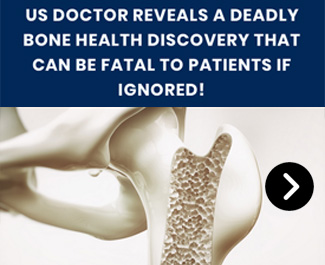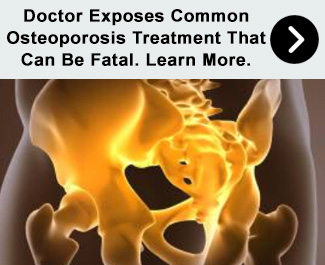Below, you’ll find must-know information about osteoporosis.
LEARN MORE NOW
Osteoporosis? How To Reverse Bone Loss & Increase Bone Density. SEE IT
Bone Health Discovery Can Be Fatal If Ignored. SEE IT
Doctor Cracks The "Bone Code" For Preventing And Treating Osteoporosis. SEE IT
If You Have Osteoporosis, Do This Immediately. SEE IT
Doctor Exposes Deadly Common Osteoporosis Treatments. SEE IT
Osteoporosis is a medical condition where the bones have become weak and brittle. (1) Women in the menopausal stage are more prone to develop this condition. Now, this does not mean that men are spared from this particular because they’re not.
Aside from gender, family history can also contribute to the onset of this condition. Other factors include low calcium intake, a sedentary lifestyle, smoking, excessive alcohol, and consumption.
If left untreated, this condition can increase the risk of bone fractures. The hip, spine, and wrist are most likely to be affected.
Fractures caused by osteoporosis can bring about significant pain, disability, and loss of independence. The individual’s quality of life can greatly be affected.
Osteoporosis can be categorized into four types. The most common one is primary osteoporosis. This occurs as a result of the natural aging process.
Another type is secondary osteoporosis. This occurs as a result of an underlying medical condition or medication that affects bone health.
Examples of conditions that can cause secondary osteoporosis include hyperthyroidism, chronic kidney disease, and rheumatoid arthritis.
Idiopathic juvenile osteoporosis is a rare form of osteoporosis that occurs in children and adolescents without an underlying medical condition. The cause of this particular type of osteoporosis is unknown.
Osteogenesis imperfecta is a genetic disorder that affects the production of collagen, a key component of bone tissue. (2)
Knowing the various symptoms of this condition can help prevent the onset of complications. Below are osteoporosis symptoms worth knowing about.
6. Fractures
Bones weakened by osteoporosis are more likely to fracture, especially in the hips, spine, and wrists. There are various causes of fractures in osteoporosis.
Age is one of the common causes of fractures in osteoporosis. As people age, their bones become weaker and more brittle, making them more prone to fractures. Another common cause is a sedentary lifestyle. Lack of physical activity can lead to bone loss and weakening bones.
Hormonal imbalances such as a decrease in estrogen levels in women after menopause, can cause bone loss and increase the risk of fractures.
5. Back Pain
Back pain is a common symptom of osteoporosis and is usually caused by vertebral compression fractures. These fractures occur when the bones in the spine become weak and collapse.
Osteoporosis can make bones more delicate, making them susceptible to fractures even from minor movements that may seem harmless. Simple actions such as lifting a grocery bag, getting out of a car, or tripping over a rug can cause fractures in individuals with osteoporosis.
4. Loss Of Height
Loss of height is another common symptom of osteoporosis. This is mostly attributed to the vertebral fractures that cause the spine to compress. When the spine is compressed, it leads to a loss of height.
The loss of height can be a gradual process and may not be noticeable until several compression fractures have occurred.
(continued next page)
Osteoporosis? How To Reverse Bone Loss & Increase Bone Density. SEE IT
Bone Health Discovery Can Be Fatal If Ignored. SEE IT
Doctor Cracks The "Bone Code" For Preventing And Treating Osteoporosis. SEE IT
If You Have Osteoporosis, Do This Immediately. SEE IT
Doctor Exposes Deadly Common Osteoporosis Treatments. SEE IT


